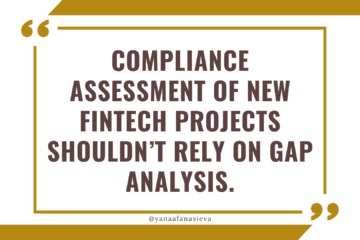FinTech Founders Cause Their Compliance Departments to Slow Down By Giving Them Wrong Resources For the Wrong Reasons
Are you a FinTech Founder or the CEO contemplating how much funds and engineering resources to allocate to your compliance team during the next 12 months? – READ THIS FIRST!
- As a FinTech founder, do you see your compliance team asking for and willing to spend more money on new hires, new tools, or new consulting, but your compliance cost per customer does not scale? No matter how much resources you have invested into compliance in the past, it has never been enough.
- Are you struggling to allocate limited resources between marketing, regulatory consultants, or hiring more engineers and you don’t know which regulatory risks are real and should be avoided and which ones are imaginary and can be tolerated?
- You as a business leader want clearer and faster decisions about risks and compliance, but instead, your company is creating new committees and having more and longer meetings about compliance and risks.
You may have tried some of the following strategies, but saw very little improvements, right?
- Hiring compliance experts from fast-growing companies, hoping that these people will know the secret sauce of how to make compliance scalable… but you don’t really know whether these other companies grew thanks to this person’s contribution or despite that… At the end of the day, the new person is very similar to their predecessor…
- De-facto taking over compliance function management and acting as the ultimate head of compliance, having all important decisions escalated to you. As a result, you are unable to focus as much as you’d like on growing your business because you are stuck with writing long explanations to regulators, auditors, bankers, and other financial partners.
- Researching competitors, signing up for their services, doing test transactions on their platform… trying to reverse-engineer their processes but this corporate espionage ends up being inconclusive because you never have full information.
- Investing into expanding your risk and compliance team and giving them more resources, hoping it would help the project grow faster, but more resources and people actually slowed the project down.
- Diversifying risks by creating more projects and more legal entities, seeking more licenses at the same time, hoping that at least one of them works faster, but you ended up over-hiring, diluting focus, and overspending on projects that were abandoned later.
- To speed up compliance decisions, you also tried networking and conferencing, hoping that extra visibility would help the project go faster, without realizing that regulators and officials who attended conferences are not the same people who grant licenses, so you still face bureaucratic hurdles even though someone promised you it should be very business friendly.
The reason why you may be stuck with perceived compliance inefficiencies and possibly compounding risks is that you never did the exercise of assessing investments into compliance using the ROI method (which is what you normally do for investments into sales or marketing), you never tried to quantify the actual benefits of investing into certain compliance processes.
The argument “it needs to be done because it is required by law” is not good. It feels like paying taxes, which makes you want to minimize it and delay it as long as possible, which is honestly just kicking the can down the road.
How to bridge this gap between compliance and business?
Don’t worry. I have helped hundreds of FinTech founders and CEOs implement the ROI method for managing compliance function as a revenue center as opposed to a cost center using my unique compliance performance training, which will accelerate the speed of your decisions, reduce the number of risks you are trying to manage and significantly simplify the documentation and efforts you need.
DM me if you need help and would like you to start right away and make sure that every $$$ spent on compliance in 2024 and beyond is useful and adds real value!


